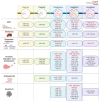MicroRNAs: A Link between Mammary Gland Development and Breast Cancer
- PMID: 36555616
- PMCID: PMC9786715
- DOI: 10.3390/ijms232415978
MicroRNAs: A Link between Mammary Gland Development and Breast Cancer
Abstract
Breast cancer is among the most common cancers in women, second to skin cancer. Mammary gland development can influence breast cancer development in later life. Processes such as proliferation, invasion, and migration during mammary gland development can often mirror processes found in breast cancer. MicroRNAs (miRNAs), small, non-coding RNAs, can repress post-transcriptional RNA expression and can regulate up to 80% of all genes. Expression of miRNAs play a key role in mammary gland development, and aberrant expression can initiate or promote breast cancer. Here, we review the role of miRNAs in mammary development and breast cancer, and potential parallel roles. A total of 32 miRNAs were found to be expressed in both mammary gland development and breast cancer. These miRNAs are involved in proliferation, metastasis, invasion, and apoptosis in both processes. Some miRNAs were found to have contradictory roles, possibly due to their ability to target many genes at once. Investigation of miRNAs and their role in mammary gland development may inform about their role in breast cancer. In particular, by studying miRNA in development, mechanisms and potential targets for breast cancer treatment may be elucidated.
Keywords: breast cancer; development; mammary gland; microRNA.
Conflict of interest statement
E.M.C. has received research support from Ocean Spray Cranberries and Lallemand Health Solutions (outside of this study).
Figures


Similar articles
-
MicroRNA-regulated gene networks during mammary cell differentiation are associated with breast cancer.Carcinogenesis. 2012 Aug;33(8):1502-11. doi: 10.1093/carcin/bgs161. Epub 2012 May 4. Carcinogenesis. 2012. PMID: 22562546
-
Characterisation of microRNA expression in post-natal mouse mammary gland development.BMC Genomics. 2009 Nov 20;10:548. doi: 10.1186/1471-2164-10-548. BMC Genomics. 2009. PMID: 19930549 Free PMC article.
-
MicroRNA expression profiling of human breast cancer identifies new markers of tumor subtype.Genome Biol. 2007;8(10):R214. doi: 10.1186/gb-2007-8-10-r214. Genome Biol. 2007. PMID: 17922911 Free PMC article.
-
[Progress on the miRNA related with mammary gland development and lactation].Yi Chuan. 2013 Jun;35(6):695-702. doi: 10.3724/sp.j.1005.2013.00695. Yi Chuan. 2013. PMID: 23774014 Review. Chinese.
-
MicroRNA involvement in mammary gland development and breast cancer.Reprod Nutr Dev. 2006 Sep-Oct;46(5):549-56. doi: 10.1051/rnd:2006026. Epub 2006 Sep 23. Reprod Nutr Dev. 2006. PMID: 17107644 Review.
Cited by
-
Hormonal regulation of miRNA during mammary gland development.Biol Open. 2024 Jun 15;13(6):bio060308. doi: 10.1242/bio.060308. Epub 2024 Jun 10. Biol Open. 2024. PMID: 38712984 Free PMC article.
-
Metformin and Breast Cancer: Current Findings and Future Perspectives from Preclinical and Clinical Studies.Pharmaceuticals (Basel). 2024 Mar 19;17(3):396. doi: 10.3390/ph17030396. Pharmaceuticals (Basel). 2024. PMID: 38543182 Free PMC article. Review.
-
Unravelling the impact of the chromobox proteins in human cancers.Cell Death Dis. 2025 Apr 2;16(1):238. doi: 10.1038/s41419-025-07585-1. Cell Death Dis. 2025. PMID: 40175347 Free PMC article. Review.
-
Cecal microbiota and mammary gland microRNA signatures are related and modifiable by dietary flaxseed with implications for breast cancer risk.Microbiol Spectr. 2024 Jan 11;12(1):e0229023. doi: 10.1128/spectrum.02290-23. Epub 2023 Dec 7. Microbiol Spectr. 2024. PMID: 38059614 Free PMC article.
-
Role of MicroRNAs in Cancer Development and Treatment.Int J Mol Sci. 2023 Jul 4;24(13):11058. doi: 10.3390/ijms241311058. Int J Mol Sci. 2023. PMID: 37446236 Free PMC article.
References
Publication types
MeSH terms
Substances
Grants and funding
LinkOut - more resources
Full Text Sources
Medical

